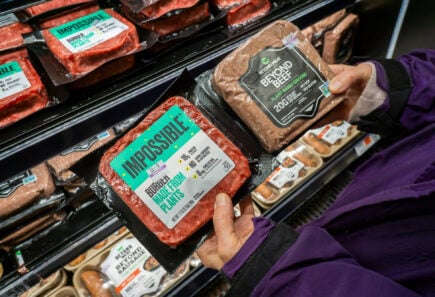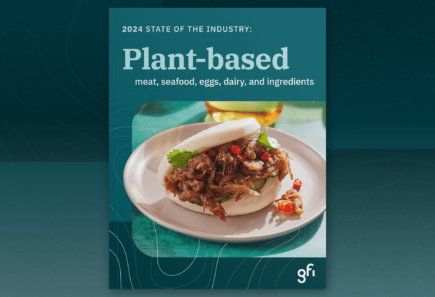Promoting plant-based items on menus
Learn best practices for marketing and promoting plant-based meat, egg, and dairy items on foodservice and restaurant menus.

Promoting plant-based meat effectively
Plant-based foods are gaining traction on menus worldwide, but how they are marketed can make or break their success. Keep reading for actionable strategies to boost sales and increase consumer adoption of plant-based meat, eggs, and dairy. From focusing on flavor and pricing to leveraging branding and team engagement, this guide will help you elevate your plant-based offerings and drive impact.
- Make flavor the primary message: Create and showcase indulgent plant-based dishes with taste-forward positioning.
- Consider pricing approach: Price is a complex issue for plant-based meat. Brands use price adjustments as crucial tools for maintaining and growing revenue, but high prices can be a barrier for consumers. Reducing plant-based meat’s price premium to conventional meat is likely to improve plant-based meat’s sales volume.
- Integrate with other dishes on the menu: Don’t isolate plant-based items in separate menu sections; integrate them with similar dishes.
- Highlight provenance
- Nationality: “All-American”
- Regional: “Southern”
- Cuisine: “Cuban”
- Preparation: “Pan-seared”
- Keep it familiar: The research is clear: familiar contexts, formats, flavors, preparation, and messaging resonate with consumers. Make commonplace dishes and utilize plant-based foods as part of familiar meals. For example, pair plant-based meatballs with marinara sauce and spaghetti.
- Add an exciting twist of novelty: Plant-based meat is well-positioned to meet the need for familiarity as well as the desire to try new and exciting foods. This is familiar food with a twist, “a delicious burger made from plants!”
- Emphasize the protein content & quality: Consumers often rely on protein as an indicator of satiety, nutrition, and feeling energized.
- Make plant-based the default choice: Presenting plant-based dishes as the default choice serves as a subtle, yet impactful way to encourage consumers to eat more plant-based foods. Consumers who are actively looking for animal-based meat can choose to opt into animal-based meat/dairy. Read more about the plant-based default approach.
- Use positive framing: Talk about what the dish offers (made from plants, plant-powered) instead of what the dish doesn’t contain (meatless, reduced meat).
- Accentuate the benefits: Consumers are already likely to associate plant-based meat with “reduced harm” benefits like being low in saturated fat and cholesterol and sustainable, but less likely to associate them with added benefits like being high in protein and vitamins and minerals.
- Use strong imagery: Pictures communicate flavor better than words!
- Use commonplace promotional placements: Show plant-based dishes alongside animal-based items to demonstrate similarity and set expectations that they will fill the same wants and needs.
- Extend your brand equity: Leverage your brand loyalty to endorse new plant-based menu items, e.g. Burger King’s Impossible burger, “0% beef, 100% Whopper.”
- Use appealing descriptors: Words to consider using: Plant protein, plant-based, veggie, 100% plant-based, 100% plants. Words to avoid or use sparingly: vegan, meat-free, meatless, vegetarian, beef-less. See our study on category descriptors for more insight.
- Mark items as plant-based or vegetarian subtly: Use small symbols. Vegan or vegetarian are seen by U.S. consumers as lifestyles rather than types of cuisine, and vegetarian/vegan consumers will find the options even without labels.
- Invest in promotion: Just like other menu items, plant-based foods benefit from good marketing and intentional advertising. Use images and videos that highlight flavor and familiarity. Host tastings, pop-up events, or giveaways to encourage customers to explore your plant-based offerings. Spotlight your plant-based menu items with creative in-store displays, such as chalkboard menus or small tabletop signs, and ensure they are highlighted on your online platforms as well.
- Get your team excited about plant-based: Train your frontline staff on how to market plant-based dishes and describe the nutritional and sustainability advantages. For free plant-based recipe development and culinary training, please contact Forward Food.
- Make sure plant-based dishes fit your brand and menu: Plant-based dishes perform best when they are positioned as a natural extension of what your consumers expect from your brand and complement the other items on your menu.
- Make sure plant-based foods integrate easily with your back-of-the-house operations: Plant-based foods need to fit with your purchasing, storage, food handling, and cooking processes. Most plant-based foods do not need to be prepared on separate cooking equipment unless your brand has a high proportion of consumers with allergies or dietary restrictions.
Explore more plant-based marketing guides
- World Resources Institute: The Food Service Playbook for Promoting Sustainable Food Choices
- Better Food Foundation: Make plant-based the default choice
- Greener by Default: Resource guide to making plant-based the default
- Forward Food: Plant-based recipe database
- Food for Climate League: Menu language workbook
Featured resources

Marketing and promoting plant-based proteins
This quick guide offers evidence-based marketing and promotion strategies to increase plant-based sales at retail.

Alternative protein company database
Explore the landscape of plant-based, cultivated, and fermentation companies including consumer brands, manufacturers, and ingredients companies.

State of the Industry: Plant-based meat, seafood, eggs, dairy, and ingredients
This report details the commercial landscape, sales, investments, innovation trends, and regulatory developments in the plant-based meat, seafood, egg, dairy, and ingredients industry.

Merchandising plant-based meat, eggs, and dairy at retail
Discover the best practices in retail merchandising, aisle signage, and shelf tags for plant-based meat, egg, and dairy.
